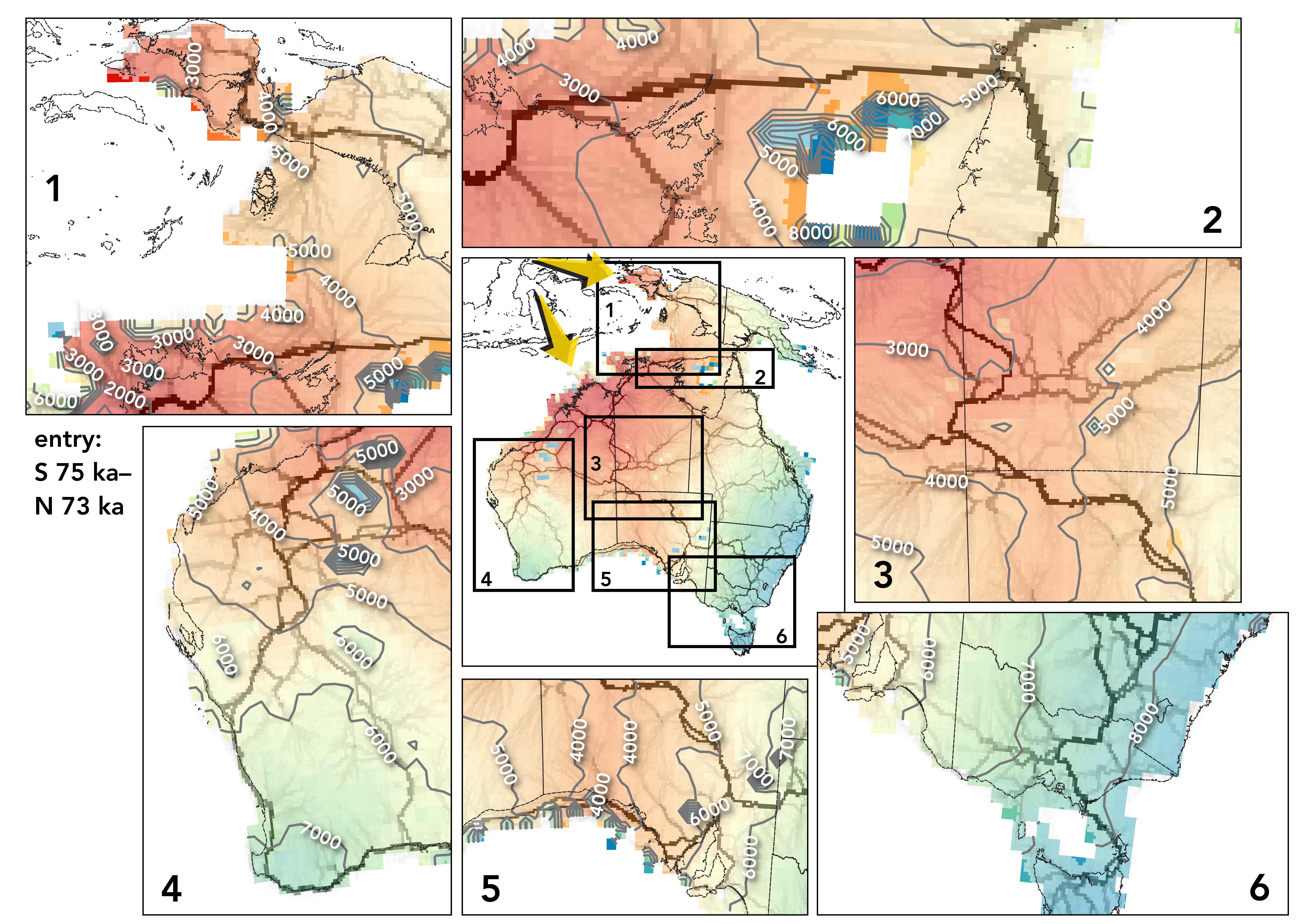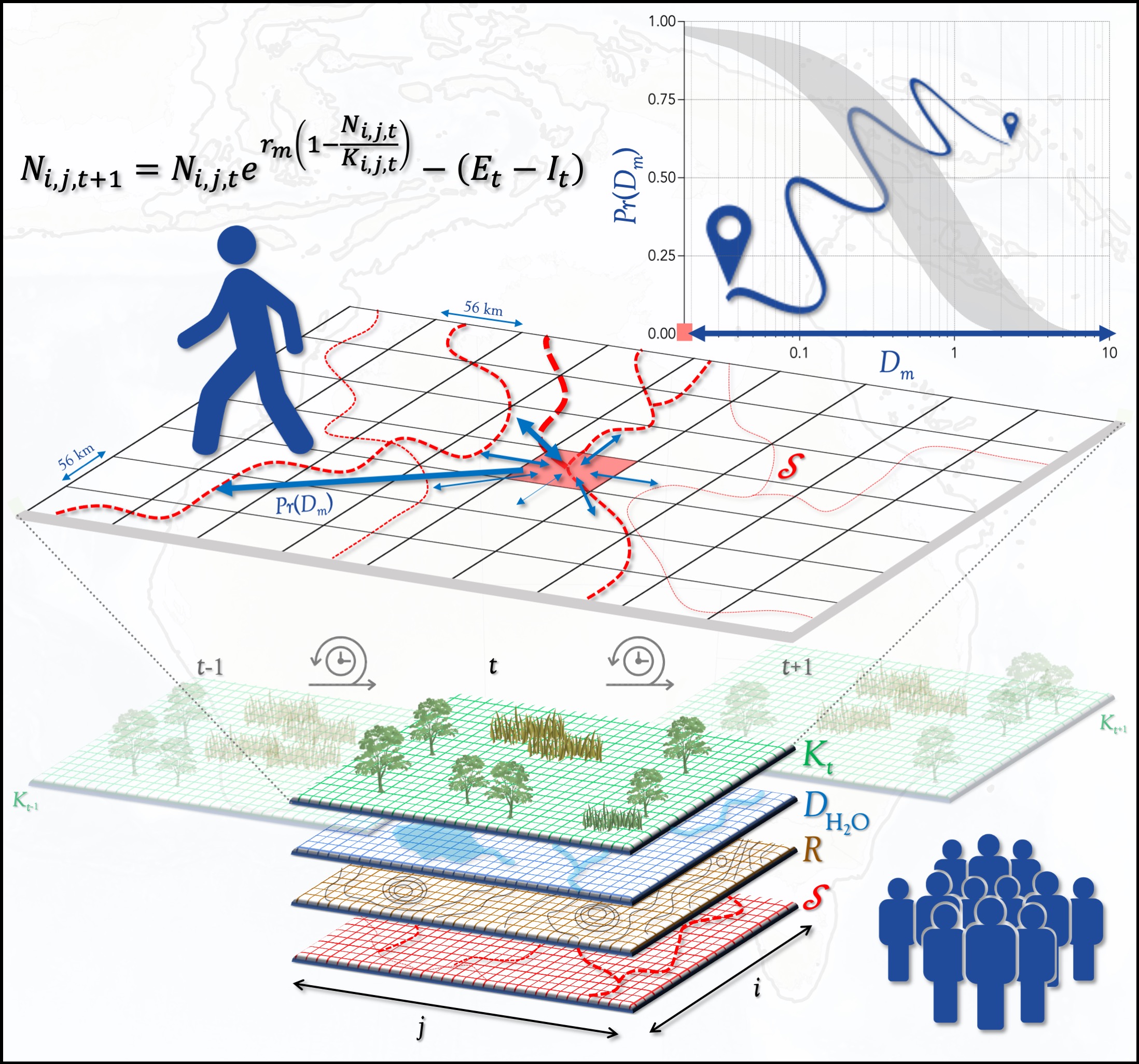Directionally supervised cellular automaton for the initial peopling of Sahul
‘Superhighways’ of human movement in Sahul1 combined with a demographic cellular automaton2
Data and R code associated with the paper:
BRADSHAW, CJA, SA CRABTREE, DA WHITE, S ULM, MI BIRD, AN WILLIAMS, F SALTRÉ. 2023. Directionally supervised cellular automaton for the initial peopling of Sahul. Quaternary Science Reviews doi:10.1016/j.quascirev.2023.107971
An earlier version of the manuscript is available as a preprint at OSF Preprints doi:10.31219/osf.io/a45fw (2022)
Abstract
Reconstructing the patterns of Homo sapiens expansion out of Africa and across the globe has been advanced using demographic and travel-cost models. However, modelled routes are ipso facto influenced by migration rates, and vice versa. We combined movement ‘superhighways’ with a demographic cellular automaton to predict one of the world’s earliest peopling events — Sahul between 75,000–50,000 years ago. Novel outcomes from the superhighways-weighted model include (i) an approximate doubling of the predicted time to continental saturation (~ 10,000 years) compared to that based on the directionally unsupervised model (~ 5,000 years), suggesting that rates of migration need to account for topographical constraints in addition to rate of saturation; (ii) a previously undetected movement corridor south through the centre of Sahul early in the expansion wave based on the scenarios assuming two dominant entry points into Sahul; and (iii) a better fit to the spatially de-biased, Signor-Lipps-corrected layer of initial arrival inferred from dated archaeological material. Our combined model infrastructure provides a data-driven means to examine how people initially moved through, settled, and abandoned different regions of the globe.
Prof Corey J. A. Bradshaw
Global Ecology, Flinders University, Adelaide, Australia
May 2022 / updated October 2022
1Crabtree, S.A. et al. Landscape rules predict optimal super-highways for the first peopling of Sahul. Nature Human Behaviour 5:1303-1313, doi:10.1038/s41562-021-01106-8 (2021) (see also relevant Github repository)
2Bradshaw, C.J.A. et al. Stochastic models support rapid peopling of Late Pleistocene Sahul. Nature Communications 12:2440, doi:10.1038/s41467-021-21551-3 (2021) (see also relevant Github repository)
Code
The R file SHSpreadPathGithub.R in the Code directory produces average scenario outputs over a set number of iterations. The user can choose the particulars of the scenario (e.g., underlying K~NPP relationship, entry time(s), entry point(s), spatial clustering, stochastic variances, minimum viable population thresholds, etc.)
The file matrixOperators.R includes necessary functions and is sourced directly within the R code file.
All code ran on the Flinders University Deepthought High-Performance Computing facility: Flinders University (2021). DeepThought (HPC). doi:10.25957/FLINDERS.HPC.DEEPTHOUGHT
Data
The two zipped files (CSV files.zip and TIF files.zip) in the data directory should be decompressed and their files placed in the same directory as the R code.
Also note that the original archaeological data used to validate both the unsupervised cellular automaton in Bradshaw et al. (2021) and the superhighways model of Crabtree et al. (2021) can be accessed using these two links: Archaeological Sites and Dates (Bradshaw et al. 2021); Supplementary Table 8 (Crabtree et al. 2021)

